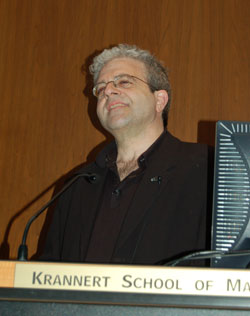Speaker explores ‘Growing Up Catholic’ in mid-20th century

Catholic scholar Robert Orsi
By Kevin Cullen (The Catholic Moment)
LAFAYETTE — Millions of middle-aged and older Catholics remember Sister Mary Margaret, their third-grade teacher. She told gory stories about the martyrs, lived and breathed The Baltimore Catechism, and made you hold your nose to the blackboard if you didn’t do your homework.
Fuel for some funny stories, yes. But noted Catholic scholar Robert Orsi says that Sister provided fervent religious formation and helped transform Catholics into one of the most educated, most successful segments of American society.
Teaching nuns in 1960 were “the most educated sisters in all Catholic history,” he said in a lecture at Purdue University Feb. 8. “They had been going to summer schools since the 1920s … The idea that these were ignorant women who knew nothing about the world was simply not the case.”
Orsi, who earned a doctorate from Yale, holds the Grace Craddock Nagle Chair in Catholic Studies at Northwestern University. His talk, titled “Growing Up Catholic: A Case Study of Catholic Children in Mid-20th Century America,” drew a crowd of approximately 150. It was based on the research he did for a book on the social and cultural history of 20th-century Catholic childhoods, which will be published by Harvard University Press.
The lecture was sponsored by the Aquinas Education Foundation and the Religious Studies Program at Purdue.
“My dad is Irish-Catholic, so it’s interesting to hear how he grew up,” said Michael O’Neill, a Purdue economics major from Indianapolis. “I grew up in Catholic schools, too. Our sisters said they would pray for us students.”
Orsi previously taught at Fordham, Indiana University and the Harvard Divinity School. He is past-president of the American Academy of Religion. The author of several books, he is an expert on Catholicism in the United States.
His research focused on Catholic children between 1925 and 1975. During that 50-year period, Catholics caught up with Protestants and Jews educationally, and by the 1970s they were more educated, and earning more, than either group, he said.
“These children were prepared for the world and did very well in it,” he said.
Catholic children, especially those taught in Catholic schools, tended to be disciplined and extremely well-versed in their faith, Orsi said. To them, supernatural things were real. Guardian angels were real. Souls in purgatory were really released. The saints depicted on religious cards shed real blood.
“Before World War II, if the crayon makers made colors just for Catholic children, they would come mostly in shades of red,” said Orsi, whose study involved interviewing adults across the country about their Catholic childhoods.
In addition to teaching academic subjects, school sisters wanted to ensure that the souls of their students were saved, he said. They made them memorize their catechisms. They stressed the sacraments, and expected them to understand complex theological concepts at an early age.
Because Catholic high schools were relatively rare, “the nuns and priests knew they had children until eighth grade,” Orsi said.
Catholic rites were solemn, and that intensified the imaginations of children. There was no such thing as a “children’s Mass.”
Some interview subjects admitted that they didn’t understand transubstantiation, and were terrified when they entered a confessional for the first time. They worried about the souls of unbaptized children in limbo, and cried when an adult told them that a beloved neighbor, who was not Catholic, could not enter heaven.
In many cases, the Church presented by adults “eluded their grasp,” he said. They were presented with “secrets and knowledge they were not ready for,” but that still prepared them for their adult roles.
Some kids tried to invent ingenious ways to “get around” Church prohibitions, especially those concerning fasting. All sorts of rumors and superstitions arose about Catholic sisters.
Still, Catholic children learned that evil was real and that the forces of grace offered protection and care, Orsi said. They saw themselves as embodied beings, and they often accepted heroic challenges. They knew that much was asked of them, both on earth and in heaven.
Today, those long-ago children are adults. Often, they like to emphasize the distance they have traveled, intellectually and spiritually, since they memorized the questions and answers of their little catechisms.
Still, they received a priceless gift. Thanks to adults who taught them their faith, Orsi said, “the world made sense.”
The Catholic Church today is “very healthy,” he said, but few Catholic children are molded as they were when Sister Mary Margaret taught school.
“It was a very powerful formation,” Orsi said. “I can’t imagine it today … it was a striking way of engaging children’s minds and hearts.”
(Go to the website of The Catholic Moment) †
